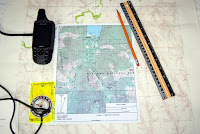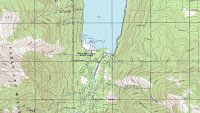Reviewing a
topographic map is usually the starting point for the planning of any back
country trip. A topographic map is your road map to the outdoors.
It provides you detailed information at a scale that is meaningful and
detailed. For years, the US Geologic Survey (USGS) has been the
principal publisher of accurate maps. Within the last decade we have
seen many innovations in mapping products that include new mapping companies
and publishers, software, maps for the GPS, and “Apps” for the iPhone.
Still, the USGS map
remains the standard for back country navigation (visit the USGS’s site at www.topomaps.usgs.gov.) I’d also recommend looking at June Fleming’s
“Staying Found” or Bjorn Kjellstrom’s “Be Expert With Map &
Compass.” Once you develop a map foundation you will easily shift to
many of the other products on the market today.
Many publications,
videos, and web sites will give you a te rundown on the features,
symbols and components to a map. This article will discuss a few of the
key features that you should be aware on a 7.5 minute map.
· Contour Lines These are the thin brown lines that snake
across the map. Contour lines connect equal points of elevation such
that every point on that line will be at that elevation above sea
level. Visually, the contour lines give you a mental three dimensional
view of the terrain. These lines provide a view of slope and pitch,
depressions, ridge lines and level ground; the highs and lows of the earth’s
surface.
· Scale Consider scale as
your view of the map; it is like your “overhead zoom” setting. To cut
to the chase, a 7.5 minute map or quadrangle has a scale that is referred to
as 1:24,000; where one inch is equal to 2000 feet. It is your best
source of information of the back country. At this scale, the map has
much more validity and provides more usable information for your backcountry
planning. You can view important landmarks, streams and geographic
features. To complete the navigation picture I always refer a second
map, such as a map of the national forest (e.g., the Deschutes National
Forest.) Commonly, such a map will be “zoomed” way out and have a scale
of 1:100,000 or 1:250,000. Imagine that such a map would be made up of
many 7.5 minute quadrangles.
· North Features on a
map such as trails, roads, mountain peaks and streams are all laid out in
relation to true North; the North Pole. The north-south borders of the
map and the small declination diagram are your best references for true
North. Other grid lines (such as the red Township, Section and Range
lines) may not be aligned to true north at all. Be careful of these
lines should you need to triangulate your position on a map.
· Declination
This is the angular difference between true North and Magnetic North.
The red needle on your magnetic compass points to Magnetic North. The
accuracy of the information found in the Declination Diagram is dependent on
the age of the map. To get the latest declination for any area visit www.magnetic-declination.com.
Personally I use a magnetic compass that I can
adjust for declination; it just makes my navigation easier. When
adjusted, my compass provides bearing information in degrees true as does my
map and my adjusted GPS.
· Coordinates
Latitude and Longitude (Lat/Long) are the familiar coordinate system to most
outdoorsmen and women. Coordinate data is found at the top and bottom
corners of each map. Lat/Long coordinate increments are also found
every 2’ (minutes) and 30” (seconds) on the sides of the Map. A scaling
device is necessary to pull complete coordinates off a map; this is a pain.
In the 1940’s a coordinate system know as
Universal Transverse Mercator (UTM) was developed. To keep a very long
story short, your 7.5 minute map has a new grid laid over it, the grid
dimensions are 1000 meters by 1000 meters. For more complete
information on UTM grid visit the USGS’s web site UTM or Lathem’s “GPS Made Easy” (which is probably at your local
library.)
Simplicity is the essence of UTM.
Scouts, hunters and hikers have joined Search and Rescue (SAR) teams around
the country in using this system.
Your GPS receiver can easily be switched to
UTM from the set-up menu.
· Bar Scales
Notice the bar scales at the bottom of the 7.5 minute map. The scales
provide measuring data in miles, feet and meters. On the far left
side of the meter scale, the scale is broken down into units of 100 meters,
this applies directly to UTM.
Notice on the scale bar (feet) that 1 inch
equals 2000 feet.
· Map Datum
Information about map datum is found in the lower left corner of a 7.5 minute
map. I have found that the simplest definition from GPS maker Garmin
is:
“A math model which depicts a part of the surface of the earth. Latitude and longitude lines on a paper map are referenced to a specific map datum. The map datum selected on a GPS receiver needs to match the datum listed on the corresponding paper map in order for position readings to match.”
The bottom line: most 7.5 minute maps are
made to the North American datum of 1927 (NAD27 or NAD27 CONUS on your
GPS). New GPS receivers are set to datum WGS84. The difference
between the datum could be over 100 meters/yards. The solution: When
pulling points off a map shift your GPS’s datum to match the map.
If precision is not an issue for your outing
don’t worry about datum.
As you begin your
trip planning don’t forget the
magnetic compass, the important partner to any topographic map. See Selecting a magnetic Compass for more information
about buying a good compass.
|
|||||
This blog is about teaching, instructing and sharing practical applications to navigation, GPS technology and survival in the backcountry.


No comments:
Post a Comment